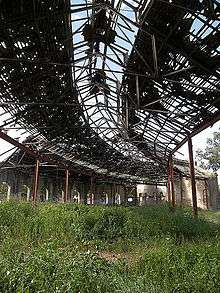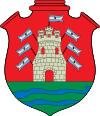Corral de Bustos
| Corral de Bustos | ||
|---|---|---|
| Town | ||
| ||
.png) | ||
| Country | Argentina | |
| Founded | 14th of November, 1901 | |
| Founded by | Carlos Von Ifflinger | |
| Elevation | 124 m (407 ft) | |
| Population | ||
| • Total | 12,000 | |
| Demonym(s) | Corralense | |
| Area code(s) | 03468 | |
Corral de Bustos is a town in Argentina located in the district of Marcos Juárez, in the south east of the Province of Córdoba.
History
The town of Corral de Bustos-Ifflinger was founded in the early Twentieth Century, when the German Carlos Von Ifflinger requested permission from the Government of the Province of Cordoba to establish a town that would carry on his surname. The government granted the permit on November 14, 1901 and this is now regarded as the founding date of the city, which originally only covered what is now Barrio Ifflinger.
In July 1902, the train service was inaugurated. The station was called baptised with the name Corral de Bustos translating into a Corale of busts, referring to an ancient Indian site in time, which was located south of Chañar Ladeado. At that time, a railroad official bought a field, now south of the tracks, there the railroad company opened streets and began selling land. One of the first buildings constructed at that location is currently operating in the DGI, in the downtown of town. In those years a school opened, the current Hipólito Yrigoyen, the post office, the police station and City Hall.
Arrival in the '30s, and the rise of Juan Perez Crespo to the Administration, the town begin to change their appearance to become what it is today. In his first term as mayor Crespo did withdrew the fronts of the houses and built brick sidewalks. He constructed the gothic facade and tower of the church. In his second term as mayor, in 1942, Crespo started great works that were the kickoff for Corral de Bustos-Ifflinger to become a city 33 years later. Major projects involved in the transformation included the abattoir, the market and soon after the first swimming pool, located in City Park. He also initiated the paving of the central streets in Corral, at the time it was known as the first town in southern Cordoba with paved streets.
With the 60s comes the flourishing local industry. with several factories that came to export their products to the European and the Latin American market.

In the 1970s the Provincial Casino arrived to the locality, along with a series of carnivals and folkloric festivals, which situated the town as a centre of nightlife for the reigon. The city became a center of attraction for residents and overnight visitors to the region. The town continues to be a very popular centre for nightlife with the people from surrounding reigons flocking to the town on the weekends to enjoy the Casino, the nightclubs (boliches) and the wide array of bars and nightclubs. [1]
Economy
The principal economic activity is agriculture, followed by livestock. Trade and industry also have some importance to the local economy, due to the presence of several textile mills.
Population
Corral de Bustos has a population counted at 11,882 habitants as of 2001 (INDEC, 2001) which represents an increase of 5.8% from the previous census with the population counted at 9,389 in 1991 (INDEC, 1991).
The town is also known as Corral de Bustos - Ifflinger, the second part of the name corresponds to the original name of the locality, which as the time passed the was designated to a part of the town known as barrio Ifflinger. It is a common to hear the residents of the city refer to themselves as 'Corrales'.
The city has two sports institutions, Sporting Club and Club Atlético Social Corralense; in football matches are usually spread throughout the South Reigonal Soccer Championships League.
References
| Wikimedia Commons has media related to Corral de Bustos. |
Coordinates: 33°17′S 62°12′W / 33.283°S 62.200°W
